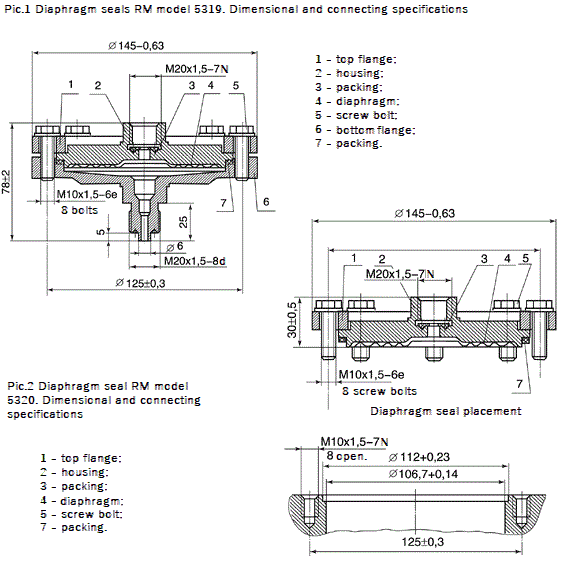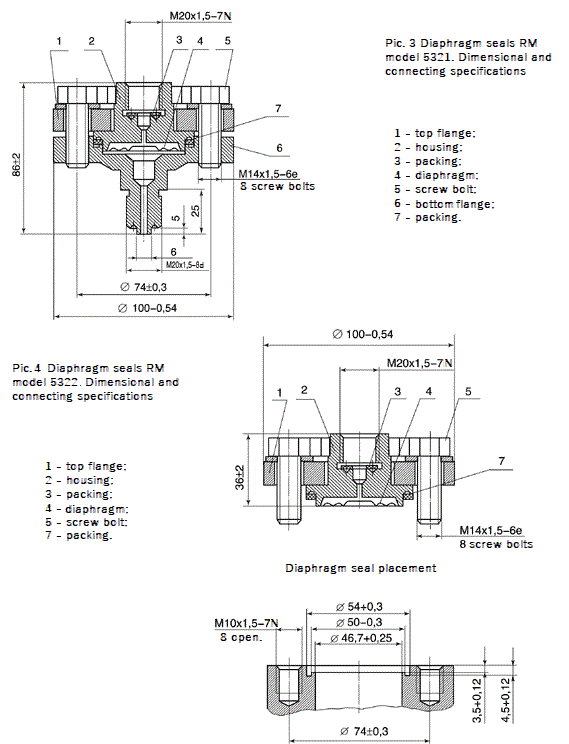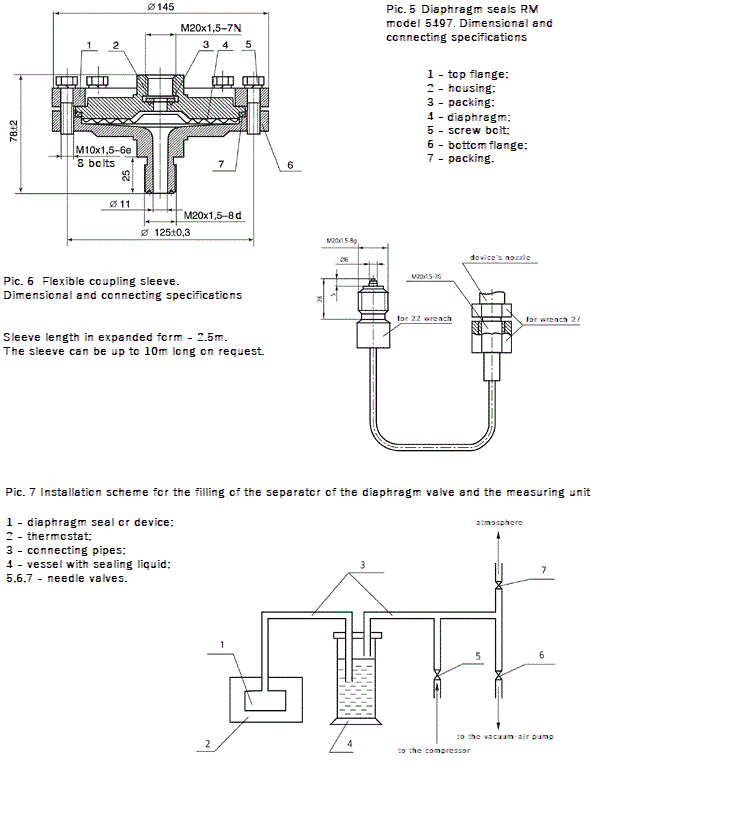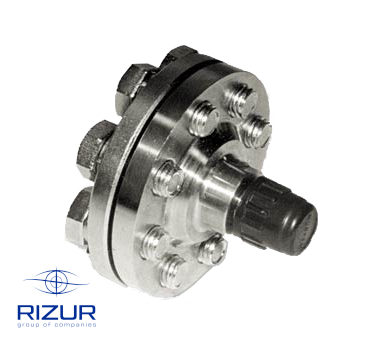Diaphragm seal RM 5319, 5320, 5321, 5322
Diaphragm seal is designed for the protection of the inside space of the measuring devices' sensing elements against penetration by aggressive, hot, crystallizing, carrying solid particles in suspension measuring media.
The connection of the separating diaphragm to the measuring device is carried out directly or through a connecting sleeve supplied on request.
The diaphragm seal is designed for the protection of the inside space of the highly-sensitive measuring equipment against penetration by aggressive, polluted or crystallizing media. The measuring device is connected to the separating diaphragm by a sleeve supplied upon the Customer’s request or upon purchase. It’s necessary to use the sleeve if the media temperature at the input is different from the set one (lower -30 ºС or above +60 ºС). The sleeve length can be up to 10 m on request.
RM 5319 is different from other diaphragm seal variants because it doesn’t influence the readings of the measuring devices (the inaccuracy is less than 1%). The inaccuracy can grow insignificantly is the media temperature at the input is not the same as the required one (each 10ºС equal 1% of inaccuracy).
The diaphragm seal construction and operating principle
The media pressure is passed through the separating diaphragm, and liquid to the sensing element connected with the diaphragm seal RM 5319. The main goal of the diaphragm: to prevent the direct contact of the media and separating liquid. Before starting operating it’s necessary to choose the maximum deformation value so that the measuring device inaccuracy when working with liquid media isn’t above 1%.
The structural design of the diaphragm seal RM 5319 is fairly simple: two flanges (top and bottom) are connected with screw-bolts. Between them there is a housing with a separating diaphragm. Some design variants of the diaphragm seal do not have a bottom flange leading to the diaphragm being opened from one side. Such design variants are called versions with an opened diaphragm. The diaphragm seals with opened membranes are mostly for working with the crystallizing media. Their construction prevents precipitation that can prevent pressure supply to the sensing elements.
The opened membrane is also available for the periodical cleaning.
RM5319 is designed in such a way that the diaphragm is protected which prolongs its service life. When choosing the design variant of the diaphragm seal, it’s necessary to take into account the characteristics of the measured liquid media as well as peculiarities of each diaphragm seal design variant.
The diaphragm seals with an opened membrane are shipped in a protective shield that prevents elastic diaphragm damage.
Upper range limit of the device complete with a separating diaphragm, MPa, (kp/cmм2):
- for design variants 5319, 5320, 5497: 0,0,25-2,5 (0,25-25)
- for design variant 5321, for design variant 5322: 4-60 (40-600)
The size of the flexible sensing element of the measuring device, cm3:
- for design variant 5319, for design variant 5320: 40
- for design variant 5321, for design variant 5322: 20
Additional measuring error caused by the separating diaphragms connected to the measuring devices should not be more than +1% of the normalizing transducer.
Temperature of the measured media at the point of entry to the separating diaphragm: from - 30 °С to + 60 °С.
Note. The separating diaphragm are always used with the connector sleeve if the temperature of the measured media at the point of entry to the separating diaphragm is above the temperature set for the operation of the measuring device.
Change in output signal or readings of the measuring device with the separating diaphragm with ambient air temperature deviation each 10°С, % from the nominal range: 1,0
Material of the separating diaphragm details contacting with the measuring media:
- diaphragm: alloy 36НХТЮ
- flange, housing: steel 12Х18Н10Т
The separating diaphragm can be manufactured from tantalum on request.
The connecting sleeve length, m: 2,5
On request the length of the connecting sleeve can be increased up to 10m.
The weight of the diaphragm, kg, not more than:
- for design variants 5319, 5497: 3,0
- for design variants 5321: 2,2
- for design variants 5320: 2,0
- for design variants 5322: 1,5
Connection and enclosure dimensions of the separators are specified on pictures 1-5, of the connecting sleeve – on picture 6.
Design and operating principle
The measured pressure is passed through the diaphragm and separating liquid to the sensing element of the measuring device connected with the separator.
The separating diaphragm protects the separating liquid from the direct contact with the measured media. The liquid and allowable deformation of the separating diaphragm are chosen so that the additional error caused by the separating diaphragm was smaller or equal to the one set in the technical data section.

The design variants of the diaphragm seals 5319 (pic. 1), 5321 (pic. 3), 5497 (pic. 5) consist of 1 top and 6 bottom flanges, connected by the screw-bolts 5, between which there’s a housing 2 with a welded diaphragm 4. The insulation between the housing and the bottom flange is carried out by the packing 7, between the measuring device and separator – by the packing 3.

In the structural design of the diaphragm seals 5320 (pic. 2) and 5322 (pic. 4) with an opened diaphragm there’s no bottom flange.

The opened diaphragm prevents the crystallizing media and solid precipitations gather in large quantities which might obstruct or cut off the pressure propagation to the sensing element. The open diaphragm is available for periodic cleaning. For open diaphragm protection against transport damages there’s a protective shield.







